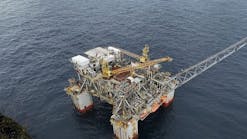Long decline in oil sector means shrinking role for Iranian supply in 'new world order'
The once-prosperous oil and gas industry of Iran has suffered great setbacks since 1979. Prior to the revolution, Iran, with oil production of 5.8 million b/d, a potential capacity of 6.3 million b/d, and an export potential of 5.4 million b/d, was the second largest oil exporter and the fourth largest oil producer in the world.
The stability and the political and economic power of Iran was fully recognized by the world and certainly by all members of the Organization of Petroleum Exporting Countries, in particular by her neighbors in the greater Persian Gulf area. Iran enjoyed a striking position of leadership and great influence in the decision-making processes of OPEC. No major policy would have been adopted in ministerial conferences of OPEC without the support and blessing of the Iranian leadership. The idea of a fourfold price increase for OPEC's oil in 1973 was formulated and promoted by Iran.
The National Iranian Oil Co. (NIOC) was very active and aggressive in the midstream sector, including the export of large volumes of gas to Europe. NIOC was also the pioneer of establishing the revolutionary formula of 75:25 profit-sharing in the Middle East and was first among the OPEC member states to enter into overseas downstream investments by establishing joint-venture refining and marketing operations in South Korea, India, South Africa, and Senegal. NIOC also was aggressively pursuing similar ventures in Europe and North America.
Massive deterioration
Today, however, 24 years after the revolution, the Iranian oil and gas industry has suffered massive losses from a lack of professional and experienced management and definitely an acute lack of domestic and foreign investments.
The Iranian economy, particularly the oil and gas industry, suffered greatly during the 1980-88 Iran-Iraq war; the oil and gas sector is still suffering from the damages inflicted upon it during this conflict. Furthermore, a number of giant Iranian oil reservoirs have experienced permanent damage as a result of overproduction and certainly of the nonexistence of the application of enhanced recovery technology.
Technically, it is an internationally accepted fact that current Iranian output has reached a plateau and production is on the wane. Presently, the only issue that heavily draws attention among NIOC officials is damage control and managing the continuous decline in production. The latest contraction in Iranian production and exports appears to have been triggered by the technical constraints in the operation and the aging of the country's giant fields—including Gachsaran, Agha Jari, Marun, Ahwaz, and Parsi—that collectively account for about 63% of Iran's productive capacity. The lack of maintenance and the aging of Iranian oil fields result in the country losing production capacity by about 200,000 b/d/year. Furthermore, NIOC has been forced to cut back and shut in some wells, due to rapid pressure drops and rising water intakes.
In addition, fast-growing domestic oil and gas consumption due to the increasing population in Iran also has caused the reduction of oil exports and the shrinkage of oil revenue. Within the next few years, Iran is set to reach a rare moment in the history of its oil industry, as domestic oil consumption overtakes exports.
London-based analysts think it is only by breaking its OPEC production quota of 3.19 million b/d that Iran is preventing exports from falling below the level of its estimated internal consumption of 1.6 million b/d. Nevertheless, considering that domestic consumption of oil and gas is growing at a rate of about 5.2%/year, it is reasonable to conclude that by the year 2018, Iran will have no oil to export.
Investment needed
Therefore, the restoration of petroleum production to prerevolution levels has been the Islamic government's highest priority. Iranian analysts estimate that $4 billion/year of investment over the next 8 years is needed for Iran to maintain its 13% share of total OPEC production, but efforts at securing capital and foreign investment in the oil and gas industry have failed. The Iran-Libya Sanctions Act (ILSA) has certainly discouraged American oil companies from investing in Iran. Thus Iran has had difficulty attracting funds from international lending institutions as a result of her economic isolation.
Iran's problems would accumulate further if we consider her shaky diplomatic relations with other Middle Eastern states and her immediate neighbors around the Persian Gulf and Caspian Sea. Iran has lost the opportunity to be a host country for transporting Caspian hydrocarbons to the open sea. Her relations with some neighbors have changed from isolation and détente to hostility at times. Consequently, Iran has lost her credibility and political leverage in OPEC. Iran's role and influence has diminished, and the country is becoming an ineffective member of OPEC.
New world order
Finally, Iran is facing a "new world order." Since the attacks of Sept. 11, 2001, America has been determined to pursue the war against terrorism to the four corners of the world if necessary and has pledged herself to nothing short of a victory.
In his State of the Union address, President George W. Bush gave a very strong message to the leaders of Iran: that the civilized world will not tolerate terrorism. He resolutely encouraged Iranians in their quest for democracy. In addition, a number of accusations have been directed toward Iran by various US officials.
Iranian leaders categorically deny all accusations and any claims of relations with terrorists, and they defy the US and seek to intimidate the world by saying that the price of crude oil will soar overnight to over $50/bbl should the US attack Iran. This scenario, true or false, remains to be seen. However, the current status of international oil supply and demand tells us otherwise.
Although oil markets are currently very tight, once the Iraqi and Venezuelan crises have been resolved, an abundance of crude oil will be available on the market. Meanwhile, global oil demand has significantly slowed in the past 2 years. It is also apparent that some OPEC members are lined up to increase their production quotas.
Likewise, non-OPEC nations are anxious to increase their production as well. And let us not forget the rapidly increasing oil and gas production in Russia. When OPEC turns down the tap, the Russians quickly make up the difference. Therefore, Russian oil and gas could enhance predictability of global energy markets and reliability of global energy supply.
However, the long decline of Iran's oil industry means that country will not live up to its potential as a major player in global energy supply for years to come.
The author
Mansour S. Kashfi is a consultant with Kashex International and Associated Resource Consultants Inc. He also lectures at Richland College and Collin County Community College near Dallas. He was a senior geologist with National Iranian Oil Co. during 1971-78, exploration manager with Petroleum Corp. of Jamaica in 1981-82, and chief petroleum geologist with the Navajo Tribe (Arizona) in 1982-84. He holds a BS in geology from the University of Tehran, an MS in geology-subsurface stratigraphy from Michigan State University, and a PhD in geology-tectonics and sedimentology from the University of Tennessee. E-mail: [email protected].

